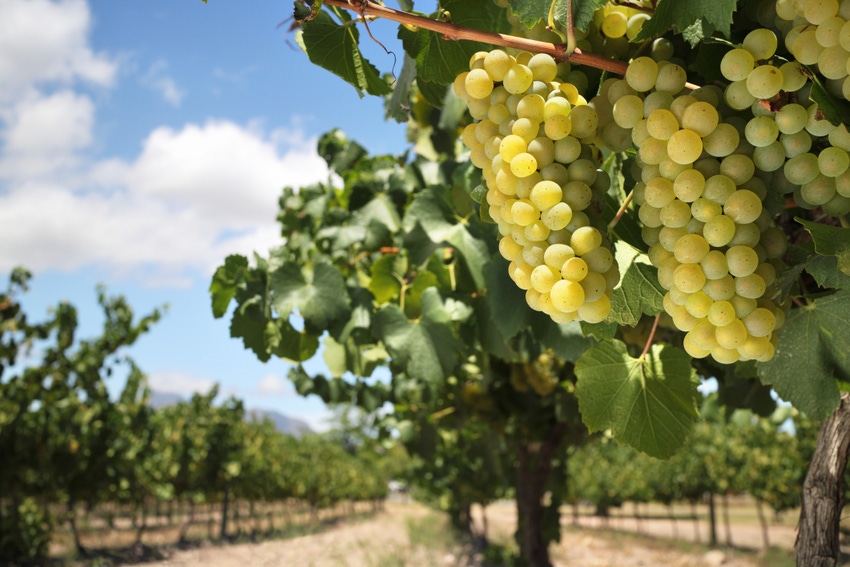
On-going efforts to arm wine grape growers in Lake and Mendocino counties with a biological weapon to defend their vines and fruit from the invasive Virginia creeper leafhopper will resume again in April when University of California Agriculture and Natural Resources scientists begin releasing more tiny wasps that destroy the leafhopper’s eggs.
The releases began on a limited basis in 2015. Results of that test encouraged the researchers to begin releasing larger numbers of the greenhouse-raised wasps, called Anagrus daanei, in the two counties, beginning last year.
This work is part of an area-wide integrated pest management program in Mendocino and Lake counties.
The Virginia creeper leafhopper favors grape varieties with few or no leaf hairs, such as Chardonnay, Grenache and Sauvignon Blanc. Feeding by this pest causes stippling of the grape vine’s leaves, disrupting photosynthesis and leading to a drop in sugar production and, consequently, grape yields and quality.
“If not controlled, the pest can defoliate the vine completely, preventing the grapes from ripening fully,” says Lucia Varela, UC Cooperative Extension North Coast IPM advisor.
A native of the Midwest, the Virginia creeper leafhopper migrated north into Canada, spreading west to British Columbia before making its way south to northern California. It was first found on a Virginia creeper vine in the backyard of a Butte County home in 1984. Twenty years later it was being seen throughout the Sacramento Valley and the Sierra Foothills areas.
“The pest is definitely spreading throughout the northern part of the state, including many areas where grapes aren’t grown,” says Varela.
Although Virginia creeper leafhopper has been found in the Sierra foothills vineyards of Eldorado and Amador counties and in one vineyard in Napa County, she’s received no reports of the pest in Sonoma County.
However, just to the north in Mendocino and Lake counties growers got their first glimpse of the pest’s potential to damage vineyards in 2011. A major outbreak of the Virginia creeper leafhopper the next year severely defoliated vines in a few vineyards.
“By 2013 we were learning how to deal with leafhopper and by improving timing of sprays it became easier to control the pest,” says Varela. “Typically, one properly-timed insecticide or IGR application, targeted to the first brood of the season, will effectively limit any damage in conventional vineyards.”
However, it’s a far different story for the large group of organic wine grape growers in Lake and Mendocino counties, she notes. There, several growers, who resorted to use of conventional insecticides in a last-ditch effort to save their heavily defoliated vineyards from the Virginia creeper leafhopper in 2012, lost their organic certification.
One organic control option is to smother the nymphs when they are very small with an organic oil, Varela notes.
“Because of little residual control, timing of the applications has to be very accurate,” she says. “It’s much harder to get good coverage with oil when the nymphs are large. Also, because the eggs hatch over a four- to six-week period, adequate control requires two application of the material.”
Pyrethrin, another option, is most effective during peak emergence of the first brood.
Varela points to the parasitic wasp as offering organic growers the best potential for controlling the Virginia creeper leafhopper. Houston Wilson, a postdoctoral researcher with the Department of Environmental Science Policy and Management, at UC Berkeley, is leading that work with Kent Daane, UC Cooperative Extension specialist based at the UC Kearney Agricultural Research and Extension Center in Parlier.
A type of fairyfly that is less than 1 mm in length, A. daanei is one of the insect world’s tiniest flying parasitoids. Researchers need a light microscope to distinguish between adult males and females.
“The wasp lays its eggs inside the eggs of the Virginia creeper leafhopper” Wilson notes. “After hatching inside the leafhopper egg, the wasp larva consumes the egg’s contents before pupating and emerging from the remains as an adult.”
What’s more, this parasitoid can produce about three generations in the time it takes for the Virginia creeper leafhopper to produce just one generation. “Given the right conditions, the number of A. daanei can explode very quickly,” Wilson says.
Normally, A. daanei parasitizes eggs of both the western grape leafhopper and the Virginia creeper leafhopper. However, in 2013, Wilson found that although a strain of A. daanei was present in Mendocino County, it was attacking only the eggs of the western grape leafhopper, leaving those of the Virginia creeper leafhopper untouched.
Further investigation led him to Yolo County where he found a strain of A. daanei that parasitize the eggs of Virginia creeper leafhopper. He released this strain for the first time in Mendocino County in July, 2015, at a vineyard near Hopland, Calif., at the rate of hundreds each week. The result was a significant increase in the amount of parasitism of the Virginia creeper leafhopper eggs.
The following year, between late April and early September, he released a total of more than 15,000 A daanei across seven vineyards in Mendocino County and two in Lake County. By the end of the trial, Wilson found a significant increase in parasitism at three of the nine sites.
This year, beginning in early April, Wilson will expand the release of A. daanei to at least 10 vineyards in Mendocino and Lake counties.
“So far we’ve had the most parasitism of the leafhopper eggs at sites where we released A. daanei early and frequently throughout the season,” Wilson says. “Our goal is to get the wasp established at a site and be able to control the Virginia creeper leafhopper on its own for the long-term as the population increases and covers a larger area without us having to come back in the meantime to make more releases.”
More information is available at the Virginia Creeper Areawide Project website: http://ucanr.edu/sites/vclh.
About the Author(s)
You May Also Like




